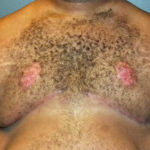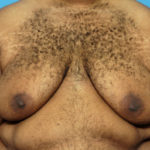Gynecomastia, or male breast enlargement, is a not uncommon problem experienced by young men. It is particularly common in teenagers and males who are overweight as there is a correlation between breast tissue enlargement and weight. While many gynecomastias are relatively small and can be easily ‘cured’ with a single operation with liposuction or excision, more severe cases pose more difficult problems.
When gynecomastia becomes large and a real saggy breast is the result, this problem defies a single operative solution or a final satisfying ideal solution. Unlike the female breast, where reductions and lifts leave scars but they are on the bottom side of the breast, the goal of gynecomastia surgery is a flat chest without a breast. Any scars that are placed on the skin, with the exception of the lower chest crease (inframmary fold), are going to be very apparent. Combine that concern with the amount of breast tissue and skin that is present mandates that a different approach be taken for these more massive gynecomastia problems.
I have found that the most satisfying method is to use a modified mastectomy technique. By removing the nipple first as a full-thickness graft, the large overhang of breast tissue and skin can be removed placing the scar along the inframammary crease. The superior skin flaps can be thinned out of breast tissue so that only a centimeter or two are left on the skin flap. When closed along the inframammary fold, a dramatic flattening of the chest can be easily obtained. The nipples are put back as skin grafts into a measured position that is optimally oriented. I must be careful to not get the nipples placed too high or too close to the sternum. This will look very unnatural.

A variation of this technique is to leave the nipples attached to the underlying breast tissue and leave them as a pedicled nipple flap. But this usually means that there will remain some fullness to the chest as the flap needs a certain thickness for the nipples to survive. This can always be liposuctioned down later.
Dr. Barry Eppley
Indianapolis, Indiana



